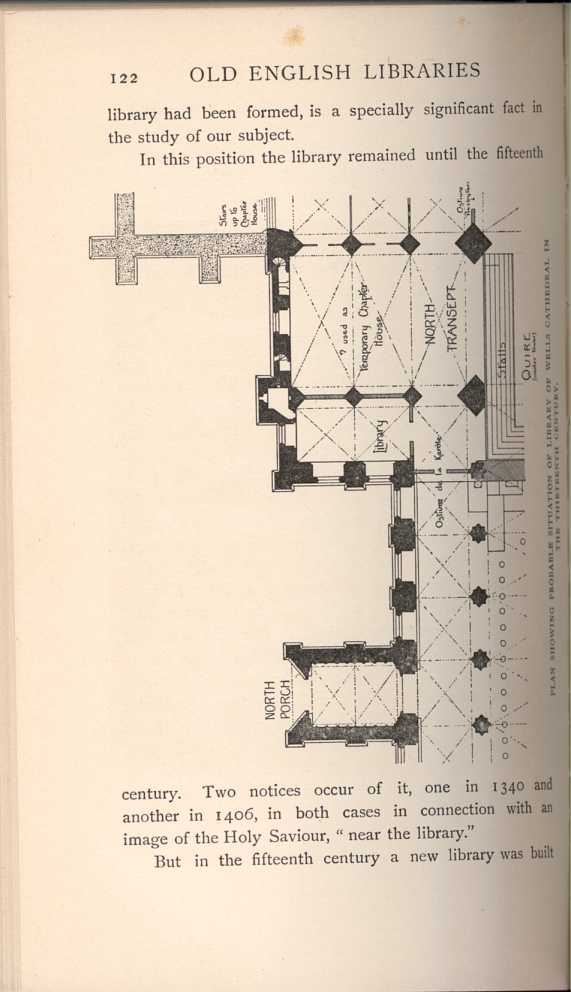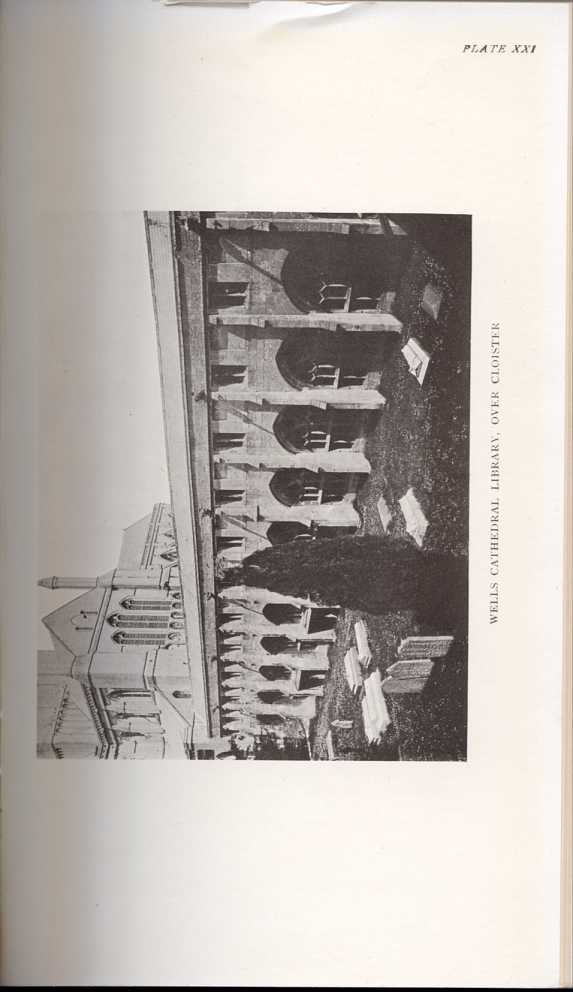| CHAPTER V: CATHEDRAL AND CHURCH LIBRARIES Old English libraries; the making, collection and use of books during the middle ages | ||
7. § VII
Although neither a monastic nor a collegiate church, Wells was already in the thirteenth century a place with some equipment for educational work. Besides the choristers' school, a schola grammaticalis of a higher grade was in existence. After 1240 the Chancellor's duties included lecturing on theology. Not improbably, therefore, a collection of books was formed very early. And indeed the Dean and Chapter in 1291 received from the Dean of Sarum books lent by the Chapter, and some others bequeathed to them. Hugo of St. Victor, Speculum de Sacramentis, and Bede, De Temporibus, were the books returned from Sarum; among those bequeathed were Augustine's Epistles and De Civitate Dei, Gregory the Great's Speculum, and John Damascenus. We know nothing of the character and size of the library at this time, although it seems to have been preserved in a special room. In 1297, the Chapter ordered the two side doors of the choir screen in the aisles to be shut at night. One door near the library (versus librarium) and the Chapter was only to be open from the first stroke of matins until the proper choir door was opened at the third bell. At other times during the day it was always to be closed, so that people could not injure the books in the library, or overhear the conferences of the Chapter (secreta capituli). This library was most likely on the north side of the church, with the Chapter House beside it, in the north transept, as shown conjecturally in the plan given in Canon Church's admirable Chapters in the Early History of the Church of Wells.[5.36] That so early, in a church neither monastic nor collegiate, a school was at work, and a
In this position the library remained until the fifteenth
 [Description: PLAN SHOWING PROBABLE SITUATION OF
LIBRARY OF WELLS CATHEDRAL IN THE THIRTEENTH CENTURY.]
[Description: PLAN SHOWING PROBABLE SITUATION OF
LIBRARY OF WELLS CATHEDRAL IN THE THIRTEENTH CENTURY.]
But in the fifteenth century a new library was built
 [Description: WELLS CATHEDRAL LIBRARY, OVER
CLOISTER.]
[Description: WELLS CATHEDRAL LIBRARY, OVER
CLOISTER.]
Shortly after the date of Bubwith's will Bishop Stafford (1425-43) gave ten books—not an inspiriting collection— but he desired to retain possession of them during his lifetime. [5.38] In 1452 Richard Browne (alias Cordone), Archdeacon of Rochester, left to the library of Wells, Petrus de Crescentiis De Agricultura, and two other books, Jerome's Epistles, and Lathbury Super librum Trenorum, which were to be kept in the church in wooden cases. [5.39] Were these cases to resemble the boxes still remaining in Exeter Cathedral? The same will ordered the Decretales of Clement, which had been borrowed for copying, to be restored to this library; two other books were also given back;
Leland only mentions forty-six books in the library in his time. "I went into the library, which whilome had been magnificently furnished with a considerable number of books by its bishops and canons, and I found great treasures of high antiquity." Among the books he found were sermons by Gregory and Ælfric in Anglo-Saxon, Terence, and "Dantes translatus in carmen Latinum." Very few books belonging to the old library before the Dissolution have survived. Some are in the British Museum, the Bodleian, and certain collegiate libraries; and several manuscripts remain in the hands of the Dean and Chapter. Among them are three manuscripts known as Liber albus I, Liber ruber II, and Liber albus III, which contain an extremely valuable series of documents.[5.41]
| CHAPTER V: CATHEDRAL AND CHURCH LIBRARIES Old English libraries; the making, collection and use of books during the middle ages | ||